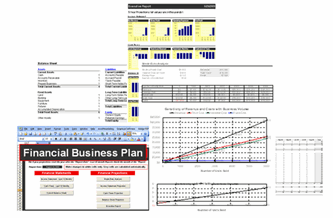Introduction
Every successful business plan is built on a solid foundation of thorough business analysis. Creating a comprehensive business plan encompasses multiple critical components including a marketing plan, financial plan, operational plan, sales forecast, and budget. To develop an effective and actionable business plan, it’s essential to follow a structured planning process.
This guide lays out a proven 10-step business planning process that helps you gather, organize, and analyze the necessary information. These steps ensure you cover all important elements to confidently set your business on the path to success.

Business Plan Templates and Software
Step 1: Analyze Stakeholders’ Requirements and Expectations
Identify and understand the needs and expectations of all stakeholders involved in your business. Stakeholders can include owners, board members, executives, investors, community members, and financial institutions.
- Clarify what success looks like for each stakeholder.
- Recognize their roles, interests, and influence on the business.
- Use this insight to align your business goals with stakeholder priorities.
Step 2: Define Vision and Strategic Goals
Create a clear and compelling vision statement for your company. Set high-level strategic goals that will serve as a roadmap for growth and decision-making.
- Ensure goals are Specific, Measurable, Achievable, Relevant, and Time-bound (SMART).
- Link these goals back to stakeholder expectations.
- This step shapes all subsequent planning activities.
Step 3: Conduct External (Environmental) Analysis
Analyze external factors influencing your business environment. This includes political, economic, social, and technological trends (often referred to as a PEST analysis).
- Identify market opportunities and potential threats.
- Stay aware of regulatory changes, economic shifts, and emerging technologies.
- Gather data to inform risk management and strategic choices.
Step 4: Industry and Competitor Analysis
Deep dive into your industry landscape and competitive environment.
- Assess your competitors’ products, pricing strategies, and market positioning.
- Analyze industry trends, customer preferences, and value chain activities.
- Identify gaps and differentiators for your business.
Step 5: Develop a Marketing Analysis
Create a detailed marketing analysis that includes customer segmentation, product portfolio review, pricing strategies, and sales forecasts.
- Segment your customers based on demographics, needs, and buying behavior.
- Understand demand for each product or service in your portfolio.
- Plan your pricing, positioning, and promotional approaches.
Step 6: Perform a SWOT Analysis
Combine all previous insights into a consolidated evaluation of your business’ Strengths, Weaknesses, Opportunities, and Threats.
- Strengths: Internal capabilities to leverage.
- Weaknesses: Internal limitations to mitigate.
- Opportunities: External chances to capitalize on.
- Threats: External risks to prepare for.
This framework is the foundation for strategic decision-making.
Step 7: Define Your Business Strategy
Craft a strategy that leverages strengths and opportunities while addressing weaknesses and threats.
- Develop your unique value proposition.
- Create detailed marketing and go-to-market plans.
- Set clear objectives for growth, market penetration, and profitability.
Step 8: Develop an Operational Plan
Outline how your strategy will be executed operationally.
- Detail key business processes, workflows, and systems.
- Assign roles and responsibilities across management and employees.
- Include sales plans and forecasts to track execution progress.
Step 9: Prepare a Financial Plan
Integrate your strategy and operational plans into a comprehensive financial plan.
- Include projections for Profit & Loss, Balance Sheet, and Cash Flow statements.
- Explain assumptions and ties to marketing and operations.
- Conduct break-even and financial ratio analyses to assess viability.
Step 10: Assemble Your Final Business Plan Document
Organize all gathered insights and plans into a clear and structured document.
- Executive Summary
- Company Overview and Stakeholders’ Analysis
- Vision, Goals, and Critical Success Factors (CSFs)
- Product and Service Portfolio Overview
- Industry and Competitor Analysis
- Marketing Analysis and Marketing Plan
- Operational Plan and Sales Forecast
- Financial Plan with Projections and Analysis
- Milestones and Performance Measurement (KPIs and Metrics)
Industry-Specific Examples
Tech Startup
- Focus heavily on rapid innovation cycles and agile operational plans.
- Include detailed competitor feature comparison and user adoption forecasts.
- Financial plan should incorporate burn rate and funding milestones.
Retail Business
- Place emphasis on inventory management and supply chain optimization within the operational plan.
- Marketing analysis should segment customers by location, age, and shopping habits.
- Financial plan includes sales per square foot and seasonal trends.
Professional Services
- Operational plan should document key service delivery processes and client management.
- Marketing strategy involves referrals, reputation management, and content marketing.
- Financials to focus on utilization rates and billable hours.
Implementation Tools
Here is a simple checklist to help you keep track of your progress through the 10-step process:
| Step | Action Item | Status | Notes |
|---|---|---|---|
| 1 | Stakeholders’ requirements analysis | ||
| 2 | Define vision and goals | ||
| 3 | External (PEST) analysis | ||
| 4 | Industry and competitor analysis | ||
| 5 | Marketing analysis | ||
| 6 | SWOT analysis | ||
| 7 | Strategy definition | ||
| 8 | Operational plan development | ||
| 9 | Financial plan preparation | ||
| 10 | Assemble final business plan document |
Use the checklist to track completion and capture insights or roadblocks. This also makes collaboration easier.
For business professionals looking to save time on detailed plan creation and financial projections, consider exploring comprehensive financial business plan Excel templates and business plan templates that simplify this process rigorously.
Additionally, automating your financial reporting using tools available at automated Excel financials can significantly enhance accuracy and productivity.
Conclusion
Following this 10-step business planning process creates a clear, actionable blueprint for your business. It helps align stakeholders, analyze the market, develop solid strategies, and prepare operational and financial frameworks. Use the accompanying tools and templates to make planning easier and more efficient.
Discover more strategies and frameworks to accelerate your business growth and profitability with the Finance & Profit Growth Toolkit.






























